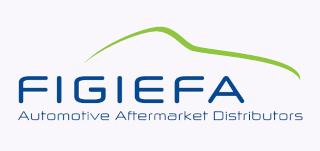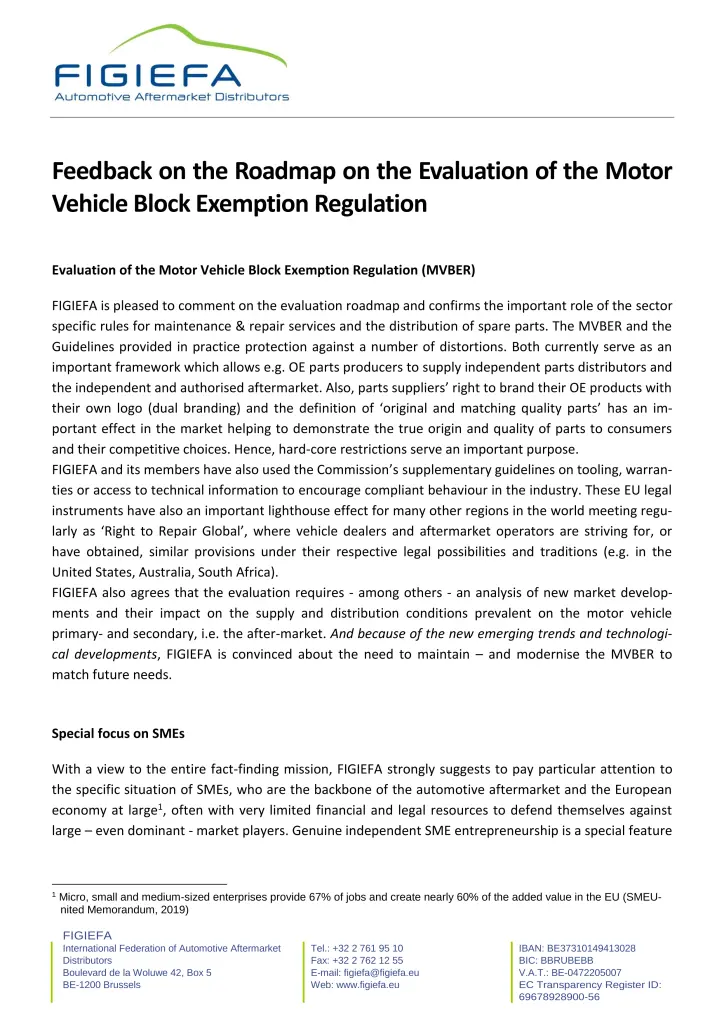FIGIEFA is pleased to comment on the evaluation roadmap and confirms the important role of the sec-tor specific rules for maintenance & repair services and the distribution of spare parts. The MVBER and the Guidelines provided in practice protection against a number of distortions. Both currently serve as an important framework which allows e.g. OE parts producers to supply independent parts distributors and the independent and authorised aftermarket. Also, parts suppliers’ right to brand their OE products with their own logo (dual branding) and the definition of ‘original and matching quality parts’ has an important effect in the market helping to demonstrate the true origin and quality of parts to consumers and their competitive choices. Hence, hard-core restrictions serve an important purpose.
FIGIEFA and its members have also used the Commission’s supplementary guidelines on tooling, warranties or access to technical information to encourage compliant behaviour in the industry. These EU legal instruments have also an important lighthouse effect for many other regions in the world meeting regularly as ‘Right to Repair Global’, where vehicle dealers and aftermarket operators are striving for, or have obtained, similar provisions under their respective legal possibilities and traditions (e.g. in the United States, Australia, South Africa).
FIGIEFA also agrees that the evaluation requires – among others – an analysis of new market developments and their impact on the supply and distribution conditions prevalent on the motor vehicle primary- and secondary, i.e. the after-market. And because of the new emerging trends and technological developments, FIGIEFA is convinced about the need to maintain – and modernise the MVBER to match future needs.
Special focus on SMEs
With a view to the entire fact-finding mission, FIGIEFA strongly suggests to pay particular attention to the specific situation of SMEs, who are the backbone of the automotive aftermarket and the European economy at large (micro, small and medium-sized enterprises provide 67% of jobs and create nearly 60% of the added value in the EU – SMEUnited Memorandum, 2019), often with very limited financial and legal resources to defend themselves against large – even dominant – market players. Genuine independent SME entrepreneurship is a special feature of Europe’s economic structure and is a guarantor for innovation, competition and consumer welfare. This should be critically considered when assessing the MVBER.
Moreover, when evaluating the MVBER and supplementary guidelines, one must consider that the current case-by-case enforcement/complaints mechanisms, form a too high hurdle, particularly for SMEs. This explains why there were hardly any formal complaints procedures. Even though a block exemption regulation does not define rights or obligations, companies are often drawn to comply with its requirements in order to benefit from the safe harbour. Hard-core restrictions may still allow for individual exemptions in theory, but in practice the incentive to observe them is very strong. The same may hold true for the Commission guidelines. FIGIEFA suggests that examining the positive effects of how specific norms in block exemption regulations/Commission guidelines can influence large companies to adopt compliant behaviours, should be part of the MVBER evaluation.
Augmented by their vulnerability in terms of enforcement and administrational burdens, the competitiveness of the SMEs depends largely on their ability to source spare parts and data. Independent repairers rely on a competitive independent multi-brand supply chain (ecosystem), which in turn relies on inputs from vehicle manufacturers.
Fairness for consumers
Commissioner Vestager rightly emphasized that competition policy needs to “make sure that our markets stay competitive enough to give consumers the power to demand a fair deal.” This presupposes alternative choices. Only under such conditions would prices be competitive and investments in innovation remain economically feasible on the aftermarket, to the benefit and welfare of consumers (with 13% the mobility/transport services are second largest expenditure of European households – Eurostat, 236/2016).
- European consumers need a fair deal when it comes to affordable mobility. Servicing, repair and spare parts are a significant cost factor to individual mobility as well as in commercial transportation, i.e. the cross-border trade in goods. Especially in rural regions where within the EU, hardly any brand-specific repair networks exist (and electric charging infrastructure is a very distant prospect), consumers and businesses should have affordable access to servicing, repair and spare parts. The main sources of competition in the automotive aftermarket are the 500.000 independent SME operators ( GEAR 2030 High Level Report market figures).
- Against this background we urge the Commission to include the competitive position of the many independent multi-brand operators throughout the supply chain in a more comprehensive way. The focus in the qualitative/quantitative study on the repair level is too restricted and does not capture the influence of the MVBER on various levels of the after-sales market and its competitive eco-systems. The complexity of the motor vehicle (aftermarket) sector and the nature of the respective economic activities should be taken into account so as to allow for a better illustration of the different competitive conditions at each level of the supply chain.
Preserving – and modernising – “MVBER 2.0”
In a 5-10 years perspective, there will still be a “MVBER legacy vehicle parc” with the need for maintenance, repair and spare parts and a vertically structured market requiring rules based on vertical restraints to ensure competition to the benefit of consumers.
At the same time, it is necessary to acknowledge that the motor vehicle is becoming ever-more computerised and complex, and this brings more technically advanced abilities to prevent, restrict and distort competition which should be captured by a “MVBER 2.0”:
- Against this background it is important to assess new means for OEMs to frustrate competition. Such hindrances can now include means to technically prevent the use of independent spare parts, e.g. through the introduction of burdensome and ‘dynamically priced’ coding requirements (“software as a product”) which make the repair with independent spare parts uncompetitive.
- Inefficiencies result also from the fact that independent parts distributors are not being able to source parts from vehicle manufacturers even though no alternative exists for many of these parts (“OE captive parts”). In practice it turned out that it is neither practicable, nor economically viable for independent repairers to be able to source them from authorised repairers. As motorist consumers expect a quick repair so that they are quickly mobile again, independent repairers need an effective ‘one-stop-shop’ parts delivery source. The ‘executive agent’ work-around solution proposed in the MVBER accompanying Commission’s Q&A document is impracticable and does not correspond to the working reality in the workshops.
New market trends and digitalisation
The automotive sector is one of the first to be significantly affected by the new emerging trends impacting all market players. These include for example ‘mobility as a service’, ‘sharing economy’ and ‘digitalisation’. It is necessary to consider updating the legal instrument of the MVBER/Guidelines framework to maintain a competitive aftermarket and mobility services market.
- Vertical restraints
FIGIEFA is concerned that the already existing imbalance between OEMs and aftermarket players will increase due to an increasingly condensed/flattened vertical integration of vehicle manufacturers in the entire supply chain. Vehicle manufacturers evolved since 2010 into new – additional – roles, entering as direct competitors into traditional independent aftermarket areas.
For example, traditionally the competition in the automotive repair and maintenance aftermarket was between the independent and authorised network workshops, but nowadays vehicle manufacturers, are no longer only active on the primary market. They have become, among others, also repairers themselves, due to more repairs also being done today remotely (e.g. resetting of fault codes, reprogramming, software updates).
Also, there are first examples where vehicle manufacturers have joined forces all together on a common Internet ordering platform for their original spare parts and thereby correspond to the role/function of an independent multi-brand spare parts distributor.
One of the traditional objectives of the MVBER was to enable effective competition by independent operators. To pursue this objective, it has become even more necessary with these new developments. The main competitors of independent repairers/operators are no longer only the authorised repairers/networks, but are nowadays also the vehicle manufacturer themselves, who have much more power and much more (in)direct technical and commercial means to frustrate effective competition by independent operators on the aftermarket.
- Digitalisation
Data is increasingly relevant for competition in the automotive aftermarket. The Commission rightly acknowledged that vehicle manufacturers are the only source of certain original data essential for aftermarket competition. With the current proprietary design of on-board platforms by vehicle manufacturers, we see an increasing grip on the entire aftermarket value chain by them. This is an additional problem to the previous existing problem that independent operators do not get equivalent access to technical repair information compared to authorised repairers, which resulted in 2010 in the non-discrimination obligation in the Supplementary guidelines to the MVBER).
The traditional comparison between the position of the dealer/authorised repairer and the independent operator (the vertical ‘non-discrimination principle’) is no longer valid, because due to the proprietary design of the in-vehicle telematics systems, the vehicle-generated data/functionalities go today directly and exclusively to the vehicle manufacturer itself, who then decides at his own discretion with whom it shares the data, or not.
This proprietary closed design of their in-vehicle telematics systems and the unique access to the vehicle, its data and functions, enables manufacturers to vertically integrate additional services, e.g. to offer bundled telematics services over the life-time of the vehicle, and even ‘free of charge’ (e.g. remote diagnostics, remote programming, service management, insurances). This has a de facto ‘competitive knock-out effect’ on all other service providers ‘around the car’. Hence, such practice should be examined.
Nowadays, the access to the aftermarket and the relationship with the customer will depend on direct access to a standardised and interoperable, in-vehicle platform i.e. the same principles of access via the existing On-Board-Diagnostics (OBD) port, but embedded in the vehicle for remote wireless communication and access to the vehicle and its data. Access to this in-vehicle platform enables all kinds of (innovative) real-time remote services, including remote real-time connected diagnostic (prognostic) services and remote repair processes. The on-board platform therefore consists of direct access to the vehicle and its essential real-time machine-generated data, but also of the essential ability to interact bidirectionally with in-vehicle functions (read and write) and the driver. Only this model enables effective competition and innovation in digital services ‘around the car’.
Fact finding mission – Market Development Study (COMP/2019/001) for the Commission
Against this background FIGIEFA invites the Commission to ensure that the competitive position of the many independent multi-brand operators who provide competitive choices for consumers throughout the supply chain, will be included in a significantly appropriate manner. The predominant look at the retail repairer level in the qualitative/quantitative tender document is too restricted and does not capture the influence of the entire after-sales market and its eco-systems. Its ability to compete determines the degree of effective competition and consumer benefits in the entire aftermarket. A more holistic approach is needed to enrich the insights in an ever more complex market, where OEMs become the benchmark for the evaluation of true competition.
Against the background of our explanations on ‘access to data/functions’, point ‘2.g’ of the qualitative indicators list in the specification of the tender document should be reassessed. It enquires about the description of “the types of vehicle-generated data provided to the authorized repairers and the conditions of independent repairers’ access to data”. Given that it is the vehicle manufacturer itself who is now the privileged controller of the in-vehicle data and resources/function, his role must be re-assessed.
Procedural steps
FIGIEFA suggests to include the European Parliament into the MVBER consultation, as in 2010.

